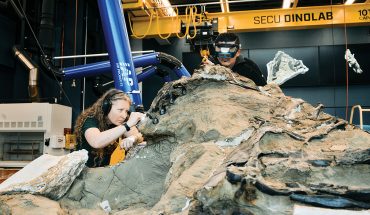
Part of the vast collection of coin-operated and novelty machines in the Fuquay-Varina home of Keith and Catherine Morris.
by Karen Lewis Taylor
photographs by Justin Cook
It began in childhood – as many grown-up interests do – when Keith Morris’s pinball-loving parents took the family to arcades.
Keith was fascinated there by the workings of the coin-operated games and novelty machines. One in particular, a vintage Rock-ola World Series baseball game, captured his then-13-year-old imagination.
“It was old, 1937, but I thought it was so cool that I went home and built one,” he says. “I made it out of scraps of wood and these old relays. I spent a lot of time tinkering with it, changing the design to make it better. But it worked!”
That he would go on to attend MIT and co-found ATI Industrial Automation, an engineering-based developer of robotic tools, underscores Keith’s knack for mechanical things. That he has since built up a well-regarded collection of antique, coin-operated machines speaks to the enduring fascination such pieces hold for him and, now, for his wife Catherine Morris.

A rare 1907 Caille Peerless roulette machine was auctioned on behalf of the heirs of John Goodson of Goodson-Todman, producers of early TV shows including Beat the Clock.
Pinball and Pachinko
Keith bought his first pinball machine in 1970, when he was in junior high.
“It was working, but I fixed it up a bit,” he says. “My mom played it when she did laundry in the basement. Then I bought another one, and when I went off to college I sold them because I needed the money.”
Over the next two decades, Keith got his master’s in mechanical engineering, married his wife Catherine, and spent two years in Japan as liaison for Lord Corporation’s industrial automation products. In 1990, he returned to lead ATI, which had acquired the product division from Lord. Catherine joined ATI’s automotive sales division in 1994.
While they brought back a few Japanese Pachinko games, which function like upright pinball machines, it wasn’t until the couple settled into their home in Fuquay-Varina that Keith revisited his childhood pastime.
“When we finished the basement, I said, ‘It would be cool to have a pinball machine down here,’ so I bought one off eBay. Then I bought another, and another. That’s fairly typical, I think, with any kind of collectibles,” he says. “You get a bit addicted.”
Fueling that interest was Keith’s itch to tinker with machines. As president of ATI, he says, “I had to work with people a lot. I didn’t use my mechanical engineering skills in the traditional sense. So I pursued outside interests to fill that need. It was very satisfying to take an old, non-functioning machine and make it work and look like new.”
Even as the collection grew to include historically significant pinball machines – including a 1936 Bally Bumper, the first machine to keep score electronically – most were there to be played.
“Our kids would have parties, and the adults couldn’t believe they were allowed to touch these things because they’re old, they’re temperamental,” Catherine says. “But Keith enjoyed it, because if they got broken then he got to fix them again.”

Keith Morris with his vintage 1937 Rock-ola World Series pinball machine and the replica he made when he was 12. He traveled nearly 2,400 miles by plane – plus a ferry ride – from Raleigh to an island off Vancouver, British Columbia, to pick up the Rock-ola.
Branching out
As ATI flourished, Keith found himself with “a little more time, space, and money – all three (of which) are needed for this hobby.” He explored online collectors’ forums and joined the Coin Operated Collectors Association (COCA) to learn more about these machines.
As former COCA president Bill Petrochuk explains, it’s a broad field.
“There were probably more than 50,000 different models of coin-operated machines made in the last 130 years,” he says. “Each collector seems to have a different reason for being attracted to a particular machine … The most attractive machines usually have some sort of ‘wow’ or ‘it’ factor that combines art, engineering, and memories.”
As Keith’s knowledge grew, his interests widened. He began collecting other vintage coin-operated machines: gambling machines such as slots and horse racing; working models, with mechanical figures depicting humorous or macabre scenes; and music machines, including a circa-1900 Regina music box he bought for Catherine.
“That was when it started for me,” she says.
The couple began attending “coin-op” shows and conventions, relishing the social aspects and tours of private collections as well as the informational sessions. On one tour in Chicago in 2004, Keith spotted a 1930 All-American Baseball game, predecessor to the 1937 Rock-ola World Series game he had loved as a kid. Although he had passed on buying the World Series game before, he returned home determined to find one.
“It’s a very rare machine, and they don’t come up for sale very often,” Catherine says of Keith’s quest.
But his networking paid off: A couple living off the coast of British Columbia were selling one, and he quickly began negotiations, arranging his travel and international shipping for the sizeable piece. “I had to deal with Canadian and U.S. customs and thought that would be a nightmare, but that turned out to be the easiest part,” he says.
The problem came as they were loading it onto the truck to catch the return ferry, when the owners’ adult son balked at parting with the family heirloom.
“He was swearing, cussing. I was thinking, ‘What have I gotten myself into? I’ve got to get out of here!’” Keith says, calling it his “most stressful acquisition.”
“I think (our acquiring that game) was probably the thing that made people start to take notice” of the collection, says Catherine.
“A rock star”
When they added on to their home six years ago, the Morrises designed a new great room around their prized pieces. In contrast to the neon-and-chrome flash of the pinball machines, which were to be housed in an expanded basement game room, the Morrisses wanted a room with a “mountain lodge feel,” Catherine says, to showcase the machines that are built into finely crafted cases and often embellished with ornate metalwork.
The work was completed in time for the Morrises to host the welcome reception when the 2012 COCA convention was held in North Carolina. “We got lots of compliments about how things were displayed,” Keith says, “because they kind of look like they’re where they belong.”
Petrochuk, who lives in Chapel Hill, remembers guests “soaking up the wonder and excitement of the Morrises’ hospitality and great collection,” noting, “Some of their pieces are rare or one-of-a-kind examples.”
One such piece is a horse racing game with no manufacturer’s information on it. “That machine came from the collection of William Harrah, of Harrah’s Casinos. He had it in his office for decades,” Keith says. “All of the old-timers were looking at it, trying to figure out who built it. It was clearly, to them, a one-of-a-kind.”
The Morrises’ highest-profile acquisition came last year, in Las Vegas, when Keith won a fierce bidding war for a rare 1907 Caille Peerless roulette machine.
“When Keith bought it, it was like he’d become a rock star,” Catherine says, making Keith laugh. “People were coming over like, ‘I want to shake your hand!’”
“Some machines will always be valuable because of their history or rarity,” Keith adds. “When I started I would buy a machine (just) because I liked it, but now I’m more interested in the uniqueness, the complexity and history of it, and how well it will hold its value.”
Yet even among such pieces, the Morrises keep a bowl of coins handy so visitors can enjoy watching their machines work. If something jams up, Keith is ready to fix it.
That would make a certain teenaged tinkerer proud.
For more on antique coin-operated machines:
Visit the Coin Operated Collectors Association website (coinopclub.org) for news, articles, videos of machines in action, and more. Website editor Bill Petrochuk also recommends books by Richard M. Bueschel, Ken Rubin, Tom Gustwiller, Bill Enes, and Marshall Fey, coin-op historians who are in the COCA Hall of Fame. You can also see vintage machines in person at the Chicagoland Show (chicagolandshow.com), which Bill calls “a must for anyone who wants to experience coin-op sensory overload,” and the Pinball Hall of Fame (pinballmuseum.org) in Las Vegas, where, Keith says, “you can go in and play.”





